Managing and Leading People
VerifiedAdded on 2023/01/12
|13
|3985
|42
AI Summary
This report evaluates the leadership style adopted for transforming Vodafone's global supply chain function and discusses the tactics used to influence external stakeholders. It also explores the model and theories used to engage key stakeholders in Vodafone.
Contribute Materials
Your contribution can guide someone’s learning journey. Share your
documents today.
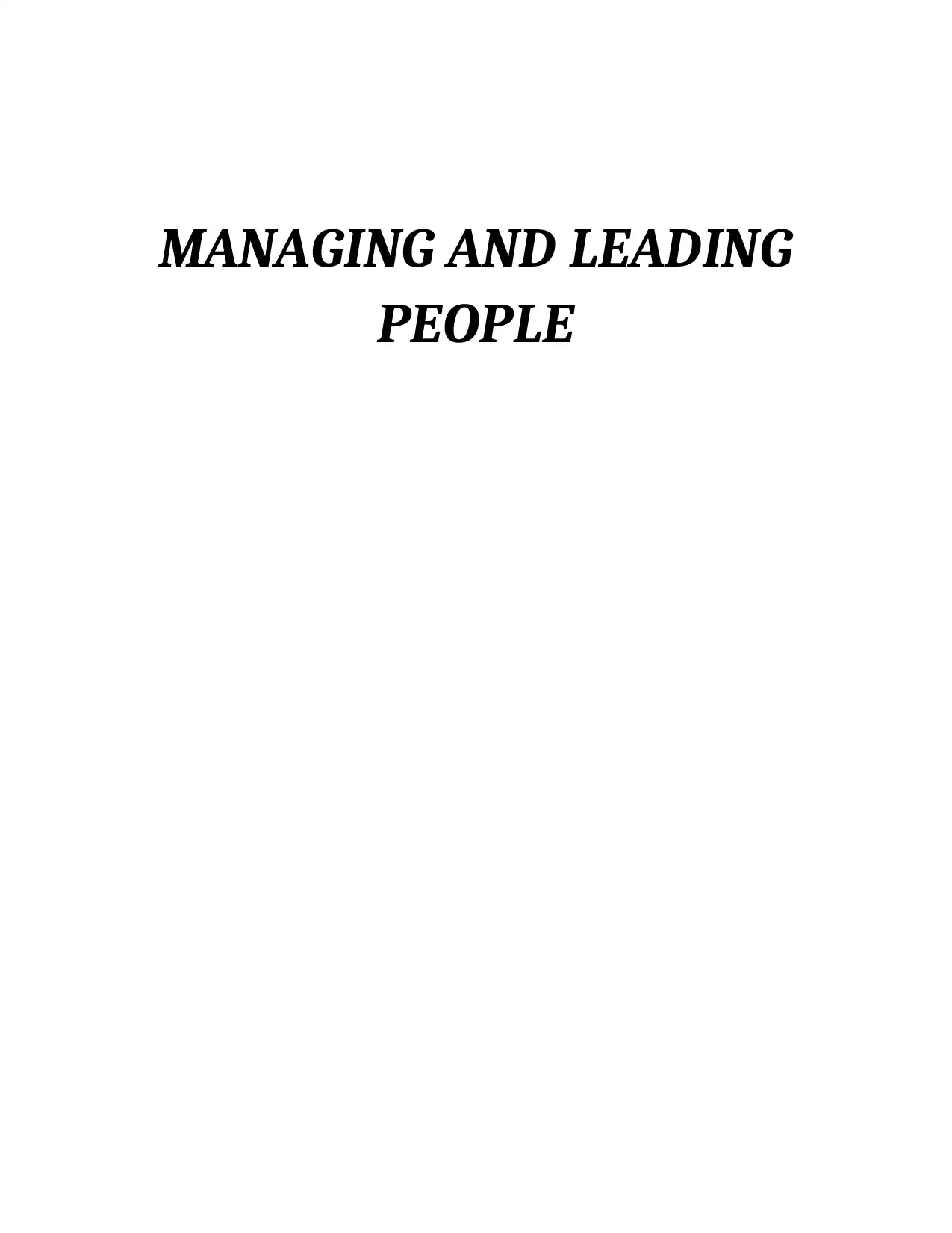
MANAGING AND LEADING
PEOPLE
PEOPLE
Secure Best Marks with AI Grader
Need help grading? Try our AI Grader for instant feedback on your assignments.
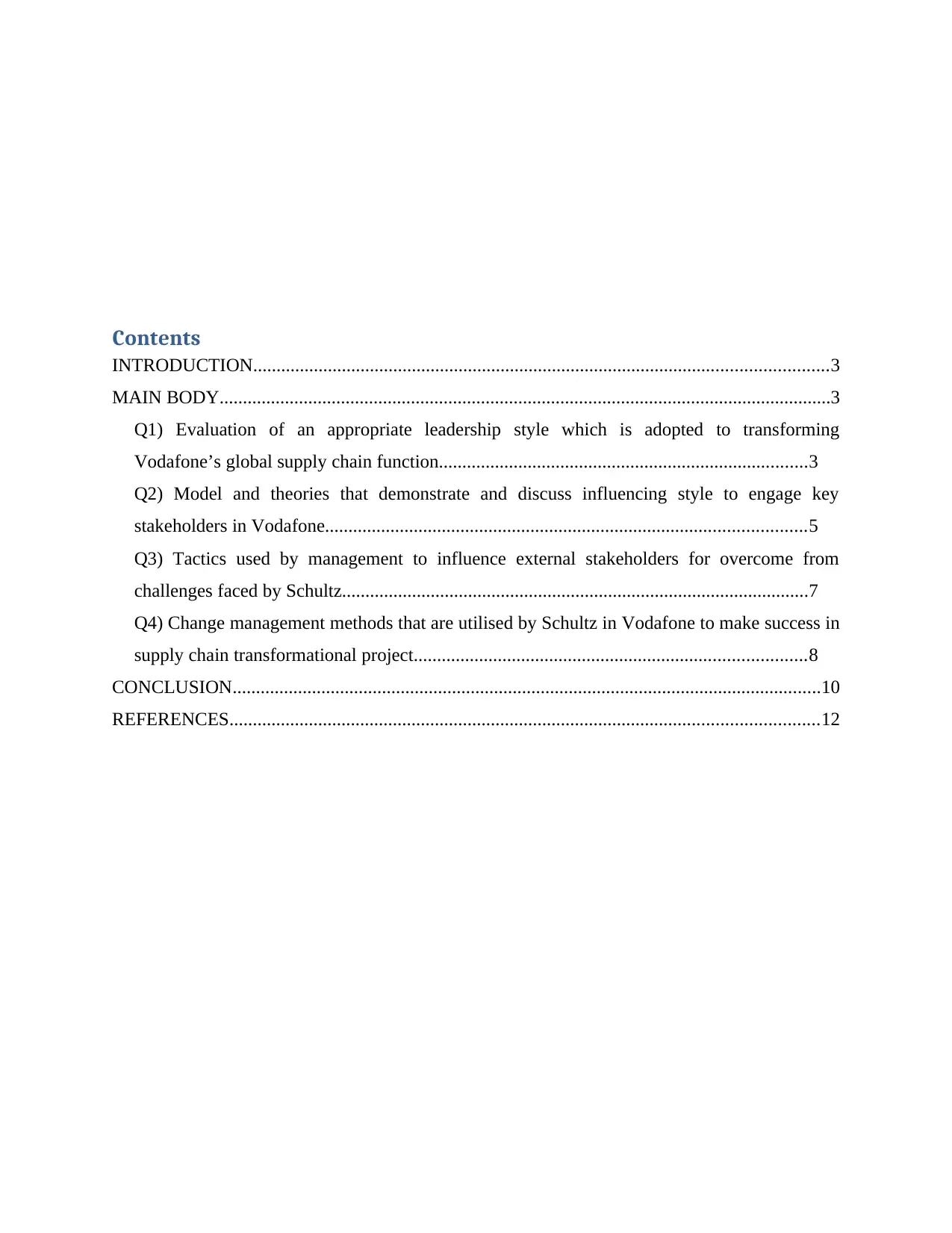
Contents
INTRODUCTION...........................................................................................................................3
MAIN BODY...................................................................................................................................3
Q1) Evaluation of an appropriate leadership style which is adopted to transforming
Vodafone’s global supply chain function...............................................................................3
Q2) Model and theories that demonstrate and discuss influencing style to engage key
stakeholders in Vodafone.......................................................................................................5
Q3) Tactics used by management to influence external stakeholders for overcome from
challenges faced by Schultz....................................................................................................7
Q4) Change management methods that are utilised by Schultz in Vodafone to make success in
supply chain transformational project....................................................................................8
CONCLUSION..............................................................................................................................10
REFERENCES..............................................................................................................................12
INTRODUCTION...........................................................................................................................3
MAIN BODY...................................................................................................................................3
Q1) Evaluation of an appropriate leadership style which is adopted to transforming
Vodafone’s global supply chain function...............................................................................3
Q2) Model and theories that demonstrate and discuss influencing style to engage key
stakeholders in Vodafone.......................................................................................................5
Q3) Tactics used by management to influence external stakeholders for overcome from
challenges faced by Schultz....................................................................................................7
Q4) Change management methods that are utilised by Schultz in Vodafone to make success in
supply chain transformational project....................................................................................8
CONCLUSION..............................................................................................................................10
REFERENCES..............................................................................................................................12
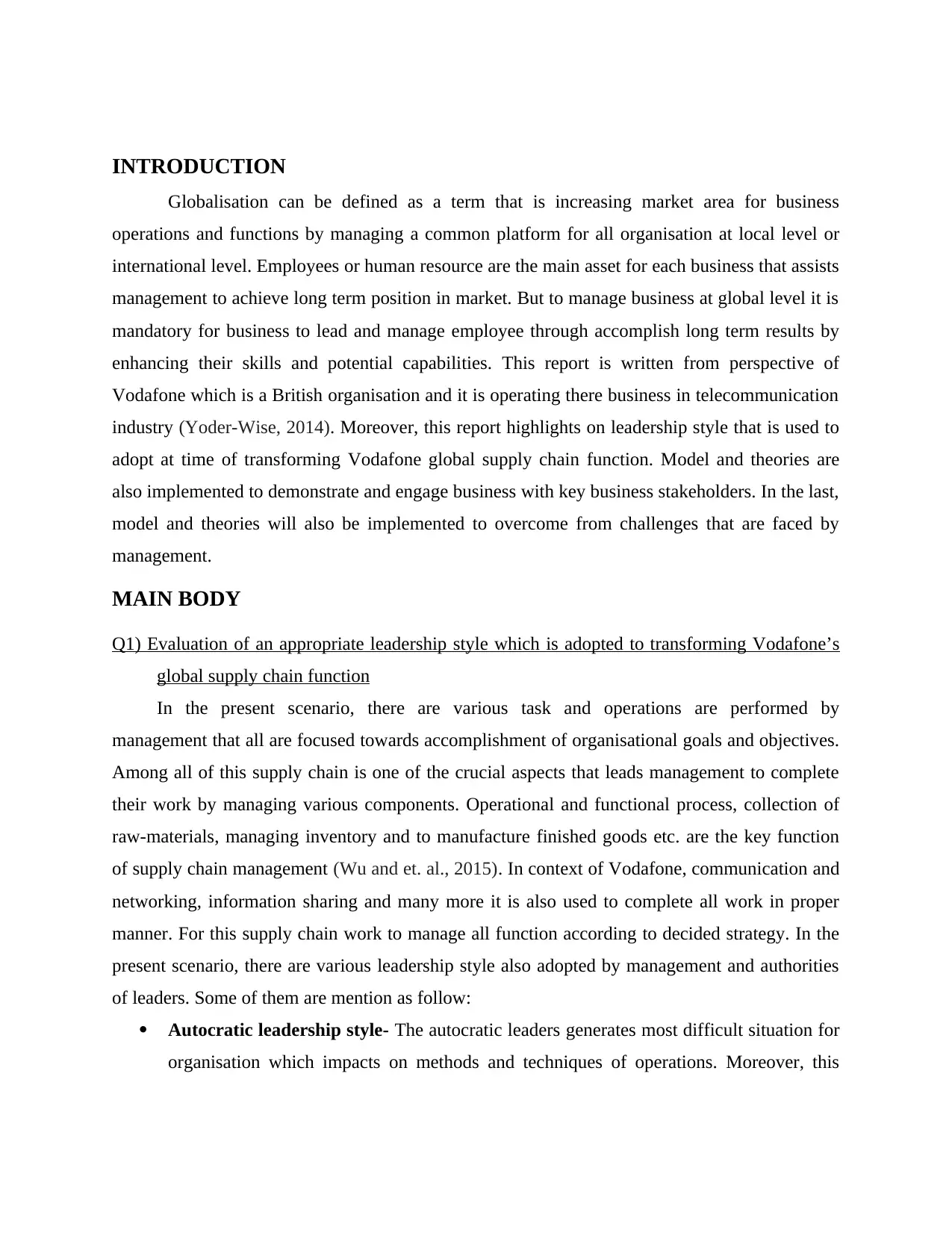
INTRODUCTION
Globalisation can be defined as a term that is increasing market area for business
operations and functions by managing a common platform for all organisation at local level or
international level. Employees or human resource are the main asset for each business that assists
management to achieve long term position in market. But to manage business at global level it is
mandatory for business to lead and manage employee through accomplish long term results by
enhancing their skills and potential capabilities. This report is written from perspective of
Vodafone which is a British organisation and it is operating there business in telecommunication
industry (Yoder-Wise, 2014). Moreover, this report highlights on leadership style that is used to
adopt at time of transforming Vodafone global supply chain function. Model and theories are
also implemented to demonstrate and engage business with key business stakeholders. In the last,
model and theories will also be implemented to overcome from challenges that are faced by
management.
MAIN BODY
Q1) Evaluation of an appropriate leadership style which is adopted to transforming Vodafone’s
global supply chain function
In the present scenario, there are various task and operations are performed by
management that all are focused towards accomplishment of organisational goals and objectives.
Among all of this supply chain is one of the crucial aspects that leads management to complete
their work by managing various components. Operational and functional process, collection of
raw-materials, managing inventory and to manufacture finished goods etc. are the key function
of supply chain management (Wu and et. al., 2015). In context of Vodafone, communication and
networking, information sharing and many more it is also used to complete all work in proper
manner. For this supply chain work to manage all function according to decided strategy. In the
present scenario, there are various leadership style also adopted by management and authorities
of leaders. Some of them are mention as follow:
Autocratic leadership style- The autocratic leaders generates most difficult situation for
organisation which impacts on methods and techniques of operations. Moreover, this
Globalisation can be defined as a term that is increasing market area for business
operations and functions by managing a common platform for all organisation at local level or
international level. Employees or human resource are the main asset for each business that assists
management to achieve long term position in market. But to manage business at global level it is
mandatory for business to lead and manage employee through accomplish long term results by
enhancing their skills and potential capabilities. This report is written from perspective of
Vodafone which is a British organisation and it is operating there business in telecommunication
industry (Yoder-Wise, 2014). Moreover, this report highlights on leadership style that is used to
adopt at time of transforming Vodafone global supply chain function. Model and theories are
also implemented to demonstrate and engage business with key business stakeholders. In the last,
model and theories will also be implemented to overcome from challenges that are faced by
management.
MAIN BODY
Q1) Evaluation of an appropriate leadership style which is adopted to transforming Vodafone’s
global supply chain function
In the present scenario, there are various task and operations are performed by
management that all are focused towards accomplishment of organisational goals and objectives.
Among all of this supply chain is one of the crucial aspects that leads management to complete
their work by managing various components. Operational and functional process, collection of
raw-materials, managing inventory and to manufacture finished goods etc. are the key function
of supply chain management (Wu and et. al., 2015). In context of Vodafone, communication and
networking, information sharing and many more it is also used to complete all work in proper
manner. For this supply chain work to manage all function according to decided strategy. In the
present scenario, there are various leadership style also adopted by management and authorities
of leaders. Some of them are mention as follow:
Autocratic leadership style- The autocratic leaders generates most difficult situation for
organisation which impacts on methods and techniques of operations. Moreover, this
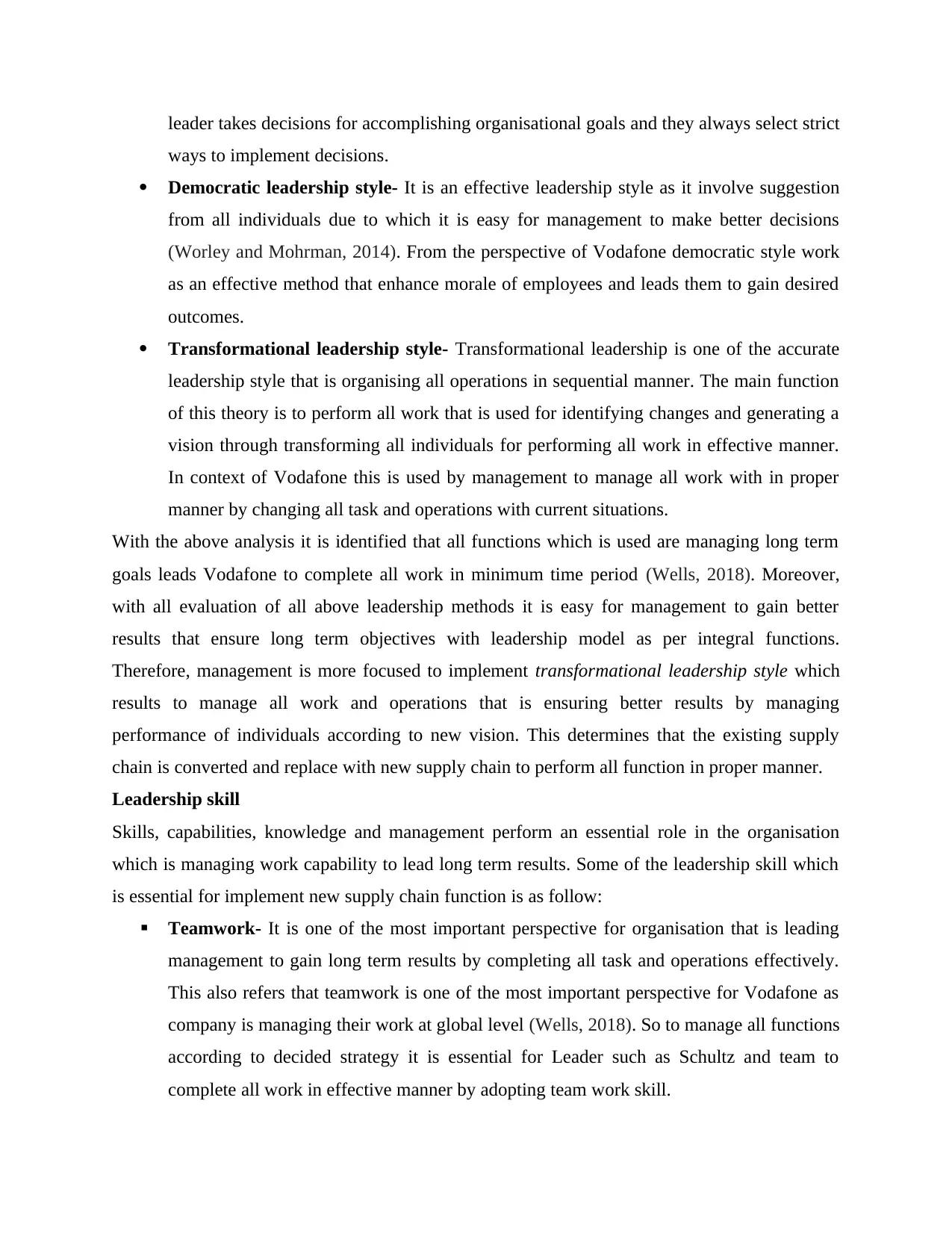
leader takes decisions for accomplishing organisational goals and they always select strict
ways to implement decisions.
Democratic leadership style- It is an effective leadership style as it involve suggestion
from all individuals due to which it is easy for management to make better decisions
(Worley and Mohrman, 2014). From the perspective of Vodafone democratic style work
as an effective method that enhance morale of employees and leads them to gain desired
outcomes.
Transformational leadership style- Transformational leadership is one of the accurate
leadership style that is organising all operations in sequential manner. The main function
of this theory is to perform all work that is used for identifying changes and generating a
vision through transforming all individuals for performing all work in effective manner.
In context of Vodafone this is used by management to manage all work with in proper
manner by changing all task and operations with current situations.
With the above analysis it is identified that all functions which is used are managing long term
goals leads Vodafone to complete all work in minimum time period (Wells, 2018). Moreover,
with all evaluation of all above leadership methods it is easy for management to gain better
results that ensure long term objectives with leadership model as per integral functions.
Therefore, management is more focused to implement transformational leadership style which
results to manage all work and operations that is ensuring better results by managing
performance of individuals according to new vision. This determines that the existing supply
chain is converted and replace with new supply chain to perform all function in proper manner.
Leadership skill
Skills, capabilities, knowledge and management perform an essential role in the organisation
which is managing work capability to lead long term results. Some of the leadership skill which
is essential for implement new supply chain function is as follow:
Teamwork- It is one of the most important perspective for organisation that is leading
management to gain long term results by completing all task and operations effectively.
This also refers that teamwork is one of the most important perspective for Vodafone as
company is managing their work at global level (Wells, 2018). So to manage all functions
according to decided strategy it is essential for Leader such as Schultz and team to
complete all work in effective manner by adopting team work skill.
ways to implement decisions.
Democratic leadership style- It is an effective leadership style as it involve suggestion
from all individuals due to which it is easy for management to make better decisions
(Worley and Mohrman, 2014). From the perspective of Vodafone democratic style work
as an effective method that enhance morale of employees and leads them to gain desired
outcomes.
Transformational leadership style- Transformational leadership is one of the accurate
leadership style that is organising all operations in sequential manner. The main function
of this theory is to perform all work that is used for identifying changes and generating a
vision through transforming all individuals for performing all work in effective manner.
In context of Vodafone this is used by management to manage all work with in proper
manner by changing all task and operations with current situations.
With the above analysis it is identified that all functions which is used are managing long term
goals leads Vodafone to complete all work in minimum time period (Wells, 2018). Moreover,
with all evaluation of all above leadership methods it is easy for management to gain better
results that ensure long term objectives with leadership model as per integral functions.
Therefore, management is more focused to implement transformational leadership style which
results to manage all work and operations that is ensuring better results by managing
performance of individuals according to new vision. This determines that the existing supply
chain is converted and replace with new supply chain to perform all function in proper manner.
Leadership skill
Skills, capabilities, knowledge and management perform an essential role in the organisation
which is managing work capability to lead long term results. Some of the leadership skill which
is essential for implement new supply chain function is as follow:
Teamwork- It is one of the most important perspective for organisation that is leading
management to gain long term results by completing all task and operations effectively.
This also refers that teamwork is one of the most important perspective for Vodafone as
company is managing their work at global level (Wells, 2018). So to manage all functions
according to decided strategy it is essential for Leader such as Schultz and team to
complete all work in effective manner by adopting team work skill.
Secure Best Marks with AI Grader
Need help grading? Try our AI Grader for instant feedback on your assignments.
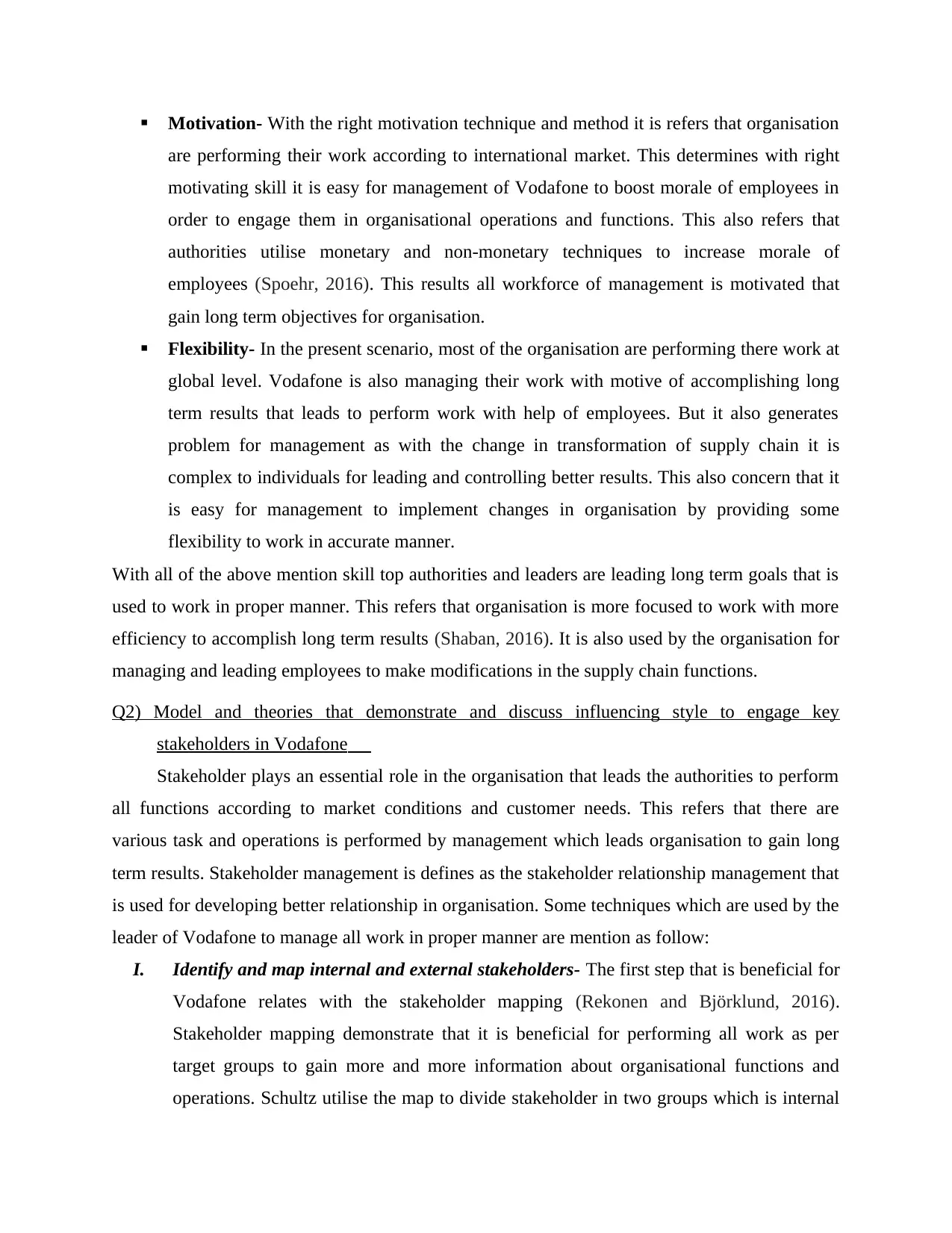
Motivation- With the right motivation technique and method it is refers that organisation
are performing their work according to international market. This determines with right
motivating skill it is easy for management of Vodafone to boost morale of employees in
order to engage them in organisational operations and functions. This also refers that
authorities utilise monetary and non-monetary techniques to increase morale of
employees (Spoehr, 2016). This results all workforce of management is motivated that
gain long term objectives for organisation.
Flexibility- In the present scenario, most of the organisation are performing there work at
global level. Vodafone is also managing their work with motive of accomplishing long
term results that leads to perform work with help of employees. But it also generates
problem for management as with the change in transformation of supply chain it is
complex to individuals for leading and controlling better results. This also concern that it
is easy for management to implement changes in organisation by providing some
flexibility to work in accurate manner.
With all of the above mention skill top authorities and leaders are leading long term goals that is
used to work in proper manner. This refers that organisation is more focused to work with more
efficiency to accomplish long term results (Shaban, 2016). It is also used by the organisation for
managing and leading employees to make modifications in the supply chain functions.
Q2) Model and theories that demonstrate and discuss influencing style to engage key
stakeholders in Vodafone
Stakeholder plays an essential role in the organisation that leads the authorities to perform
all functions according to market conditions and customer needs. This refers that there are
various task and operations is performed by management which leads organisation to gain long
term results. Stakeholder management is defines as the stakeholder relationship management that
is used for developing better relationship in organisation. Some techniques which are used by the
leader of Vodafone to manage all work in proper manner are mention as follow:
I. Identify and map internal and external stakeholders- The first step that is beneficial for
Vodafone relates with the stakeholder mapping (Rekonen and Björklund, 2016).
Stakeholder mapping demonstrate that it is beneficial for performing all work as per
target groups to gain more and more information about organisational functions and
operations. Schultz utilise the map to divide stakeholder in two groups which is internal
are performing their work according to international market. This determines with right
motivating skill it is easy for management of Vodafone to boost morale of employees in
order to engage them in organisational operations and functions. This also refers that
authorities utilise monetary and non-monetary techniques to increase morale of
employees (Spoehr, 2016). This results all workforce of management is motivated that
gain long term objectives for organisation.
Flexibility- In the present scenario, most of the organisation are performing there work at
global level. Vodafone is also managing their work with motive of accomplishing long
term results that leads to perform work with help of employees. But it also generates
problem for management as with the change in transformation of supply chain it is
complex to individuals for leading and controlling better results. This also concern that it
is easy for management to implement changes in organisation by providing some
flexibility to work in accurate manner.
With all of the above mention skill top authorities and leaders are leading long term goals that is
used to work in proper manner. This refers that organisation is more focused to work with more
efficiency to accomplish long term results (Shaban, 2016). It is also used by the organisation for
managing and leading employees to make modifications in the supply chain functions.
Q2) Model and theories that demonstrate and discuss influencing style to engage key
stakeholders in Vodafone
Stakeholder plays an essential role in the organisation that leads the authorities to perform
all functions according to market conditions and customer needs. This refers that there are
various task and operations is performed by management which leads organisation to gain long
term results. Stakeholder management is defines as the stakeholder relationship management that
is used for developing better relationship in organisation. Some techniques which are used by the
leader of Vodafone to manage all work in proper manner are mention as follow:
I. Identify and map internal and external stakeholders- The first step that is beneficial for
Vodafone relates with the stakeholder mapping (Rekonen and Björklund, 2016).
Stakeholder mapping demonstrate that it is beneficial for performing all work as per
target groups to gain more and more information about organisational functions and
operations. Schultz utilise the map to divide stakeholder in two groups which is internal
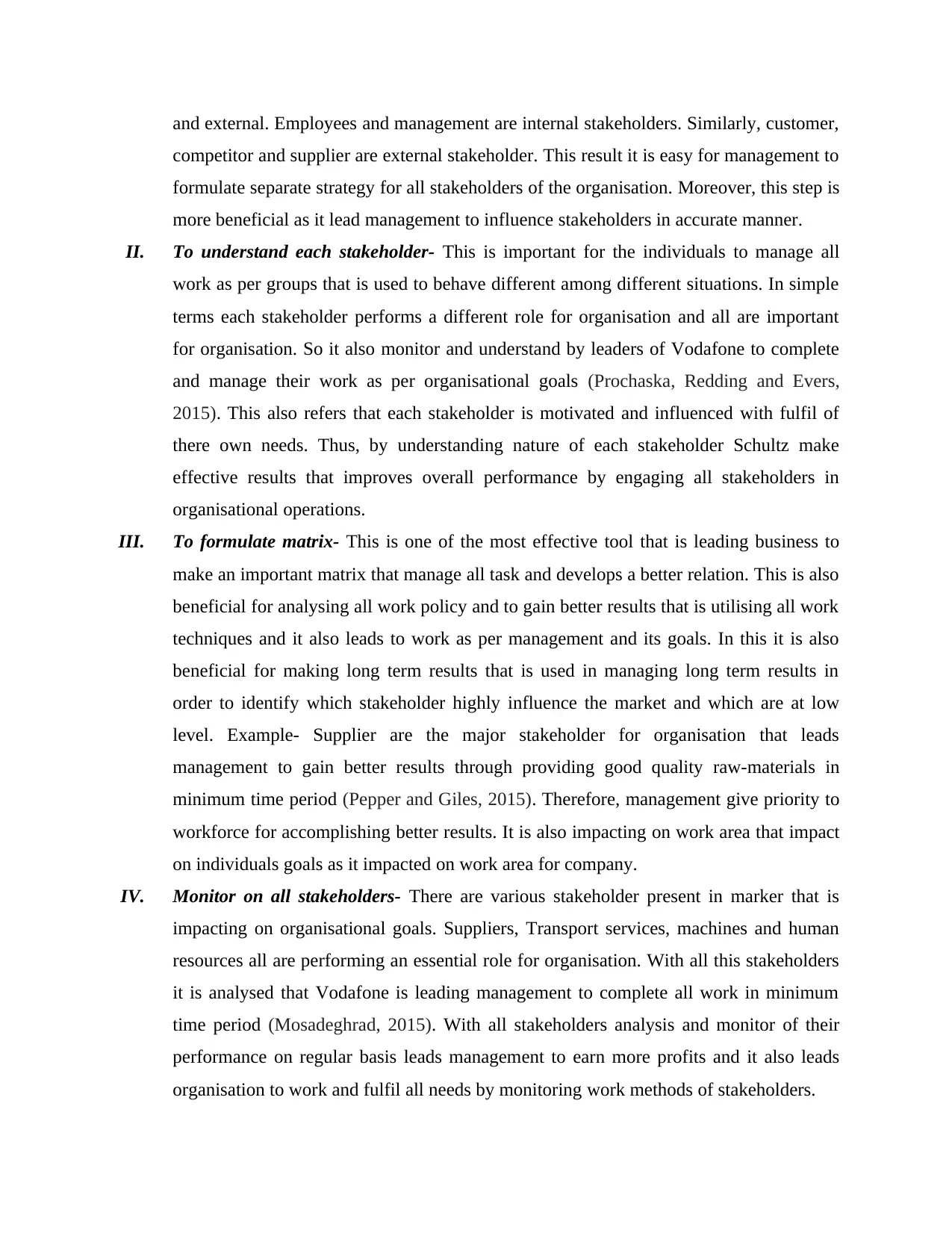
and external. Employees and management are internal stakeholders. Similarly, customer,
competitor and supplier are external stakeholder. This result it is easy for management to
formulate separate strategy for all stakeholders of the organisation. Moreover, this step is
more beneficial as it lead management to influence stakeholders in accurate manner.
II. To understand each stakeholder- This is important for the individuals to manage all
work as per groups that is used to behave different among different situations. In simple
terms each stakeholder performs a different role for organisation and all are important
for organisation. So it also monitor and understand by leaders of Vodafone to complete
and manage their work as per organisational goals (Prochaska, Redding and Evers,
2015). This also refers that each stakeholder is motivated and influenced with fulfil of
there own needs. Thus, by understanding nature of each stakeholder Schultz make
effective results that improves overall performance by engaging all stakeholders in
organisational operations.
III. To formulate matrix- This is one of the most effective tool that is leading business to
make an important matrix that manage all task and develops a better relation. This is also
beneficial for analysing all work policy and to gain better results that is utilising all work
techniques and it also leads to work as per management and its goals. In this it is also
beneficial for making long term results that is used in managing long term results in
order to identify which stakeholder highly influence the market and which are at low
level. Example- Supplier are the major stakeholder for organisation that leads
management to gain better results through providing good quality raw-materials in
minimum time period (Pepper and Giles, 2015). Therefore, management give priority to
workforce for accomplishing better results. It is also impacting on work area that impact
on individuals goals as it impacted on work area for company.
IV. Monitor on all stakeholders- There are various stakeholder present in marker that is
impacting on organisational goals. Suppliers, Transport services, machines and human
resources all are performing an essential role for organisation. With all this stakeholders
it is analysed that Vodafone is leading management to complete all work in minimum
time period (Mosadeghrad, 2015). With all stakeholders analysis and monitor of their
performance on regular basis leads management to earn more profits and it also leads
organisation to work and fulfil all needs by monitoring work methods of stakeholders.
competitor and supplier are external stakeholder. This result it is easy for management to
formulate separate strategy for all stakeholders of the organisation. Moreover, this step is
more beneficial as it lead management to influence stakeholders in accurate manner.
II. To understand each stakeholder- This is important for the individuals to manage all
work as per groups that is used to behave different among different situations. In simple
terms each stakeholder performs a different role for organisation and all are important
for organisation. So it also monitor and understand by leaders of Vodafone to complete
and manage their work as per organisational goals (Prochaska, Redding and Evers,
2015). This also refers that each stakeholder is motivated and influenced with fulfil of
there own needs. Thus, by understanding nature of each stakeholder Schultz make
effective results that improves overall performance by engaging all stakeholders in
organisational operations.
III. To formulate matrix- This is one of the most effective tool that is leading business to
make an important matrix that manage all task and develops a better relation. This is also
beneficial for analysing all work policy and to gain better results that is utilising all work
techniques and it also leads to work as per management and its goals. In this it is also
beneficial for making long term results that is used in managing long term results in
order to identify which stakeholder highly influence the market and which are at low
level. Example- Supplier are the major stakeholder for organisation that leads
management to gain better results through providing good quality raw-materials in
minimum time period (Pepper and Giles, 2015). Therefore, management give priority to
workforce for accomplishing better results. It is also impacting on work area that impact
on individuals goals as it impacted on work area for company.
IV. Monitor on all stakeholders- There are various stakeholder present in marker that is
impacting on organisational goals. Suppliers, Transport services, machines and human
resources all are performing an essential role for organisation. With all this stakeholders
it is analysed that Vodafone is leading management to complete all work in minimum
time period (Mosadeghrad, 2015). With all stakeholders analysis and monitor of their
performance on regular basis leads management to earn more profits and it also leads
organisation to work and fulfil all needs by monitoring work methods of stakeholders.
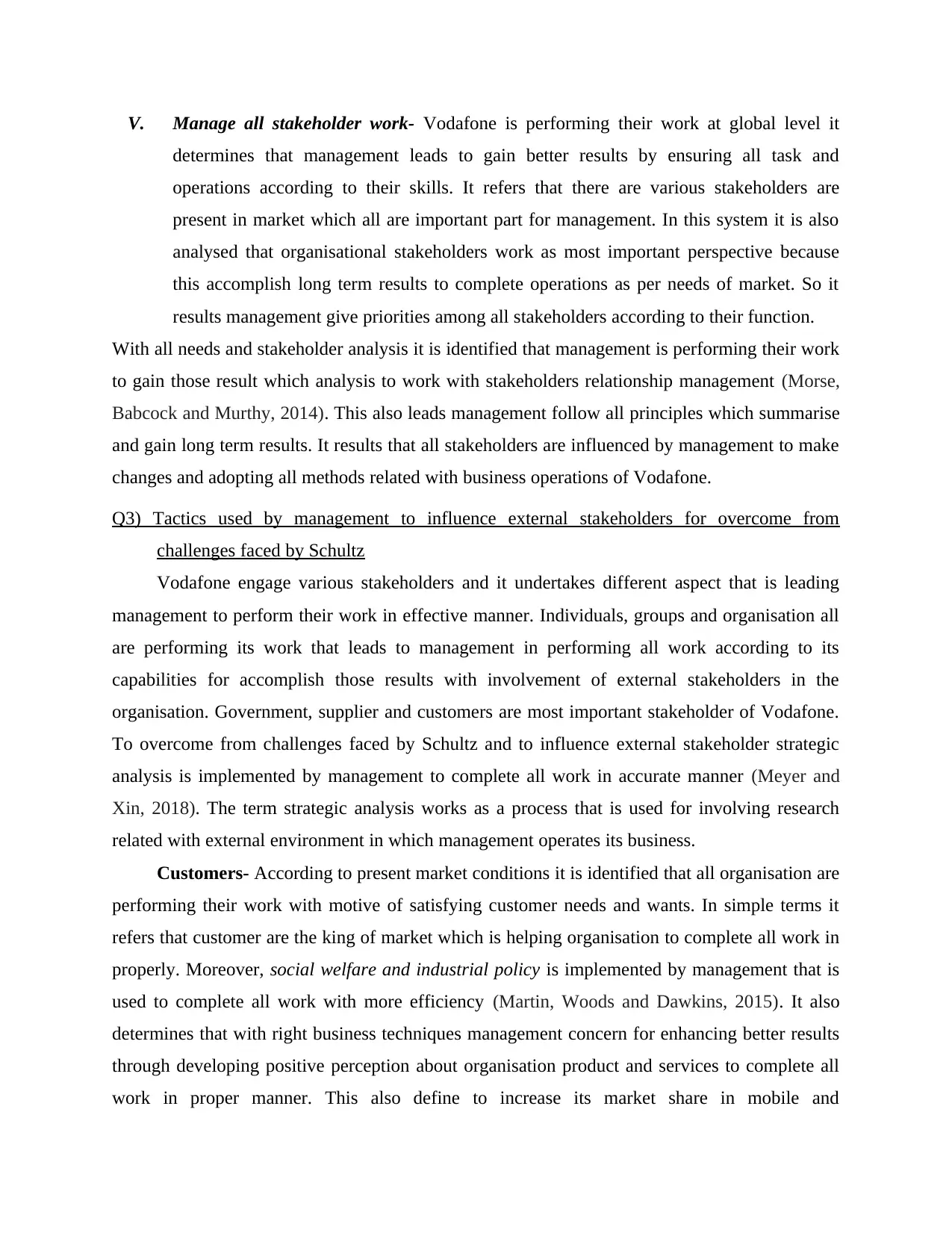
V. Manage all stakeholder work- Vodafone is performing their work at global level it
determines that management leads to gain better results by ensuring all task and
operations according to their skills. It refers that there are various stakeholders are
present in market which all are important part for management. In this system it is also
analysed that organisational stakeholders work as most important perspective because
this accomplish long term results to complete operations as per needs of market. So it
results management give priorities among all stakeholders according to their function.
With all needs and stakeholder analysis it is identified that management is performing their work
to gain those result which analysis to work with stakeholders relationship management (Morse,
Babcock and Murthy, 2014). This also leads management follow all principles which summarise
and gain long term results. It results that all stakeholders are influenced by management to make
changes and adopting all methods related with business operations of Vodafone.
Q3) Tactics used by management to influence external stakeholders for overcome from
challenges faced by Schultz
Vodafone engage various stakeholders and it undertakes different aspect that is leading
management to perform their work in effective manner. Individuals, groups and organisation all
are performing its work that leads to management in performing all work according to its
capabilities for accomplish those results with involvement of external stakeholders in the
organisation. Government, supplier and customers are most important stakeholder of Vodafone.
To overcome from challenges faced by Schultz and to influence external stakeholder strategic
analysis is implemented by management to complete all work in accurate manner (Meyer and
Xin, 2018). The term strategic analysis works as a process that is used for involving research
related with external environment in which management operates its business.
Customers- According to present market conditions it is identified that all organisation are
performing their work with motive of satisfying customer needs and wants. In simple terms it
refers that customer are the king of market which is helping organisation to complete all work in
properly. Moreover, social welfare and industrial policy is implemented by management that is
used to complete all work with more efficiency (Martin, Woods and Dawkins, 2015). It also
determines that with right business techniques management concern for enhancing better results
through developing positive perception about organisation product and services to complete all
work in proper manner. This also define to increase its market share in mobile and
determines that management leads to gain better results by ensuring all task and
operations according to their skills. It refers that there are various stakeholders are
present in market which all are important part for management. In this system it is also
analysed that organisational stakeholders work as most important perspective because
this accomplish long term results to complete operations as per needs of market. So it
results management give priorities among all stakeholders according to their function.
With all needs and stakeholder analysis it is identified that management is performing their work
to gain those result which analysis to work with stakeholders relationship management (Morse,
Babcock and Murthy, 2014). This also leads management follow all principles which summarise
and gain long term results. It results that all stakeholders are influenced by management to make
changes and adopting all methods related with business operations of Vodafone.
Q3) Tactics used by management to influence external stakeholders for overcome from
challenges faced by Schultz
Vodafone engage various stakeholders and it undertakes different aspect that is leading
management to perform their work in effective manner. Individuals, groups and organisation all
are performing its work that leads to management in performing all work according to its
capabilities for accomplish those results with involvement of external stakeholders in the
organisation. Government, supplier and customers are most important stakeholder of Vodafone.
To overcome from challenges faced by Schultz and to influence external stakeholder strategic
analysis is implemented by management to complete all work in accurate manner (Meyer and
Xin, 2018). The term strategic analysis works as a process that is used for involving research
related with external environment in which management operates its business.
Customers- According to present market conditions it is identified that all organisation are
performing their work with motive of satisfying customer needs and wants. In simple terms it
refers that customer are the king of market which is helping organisation to complete all work in
properly. Moreover, social welfare and industrial policy is implemented by management that is
used to complete all work with more efficiency (Martin, Woods and Dawkins, 2015). It also
determines that with right business techniques management concern for enhancing better results
through developing positive perception about organisation product and services to complete all
work in proper manner. This also define to increase its market share in mobile and
Paraphrase This Document
Need a fresh take? Get an instant paraphrase of this document with our AI Paraphraser
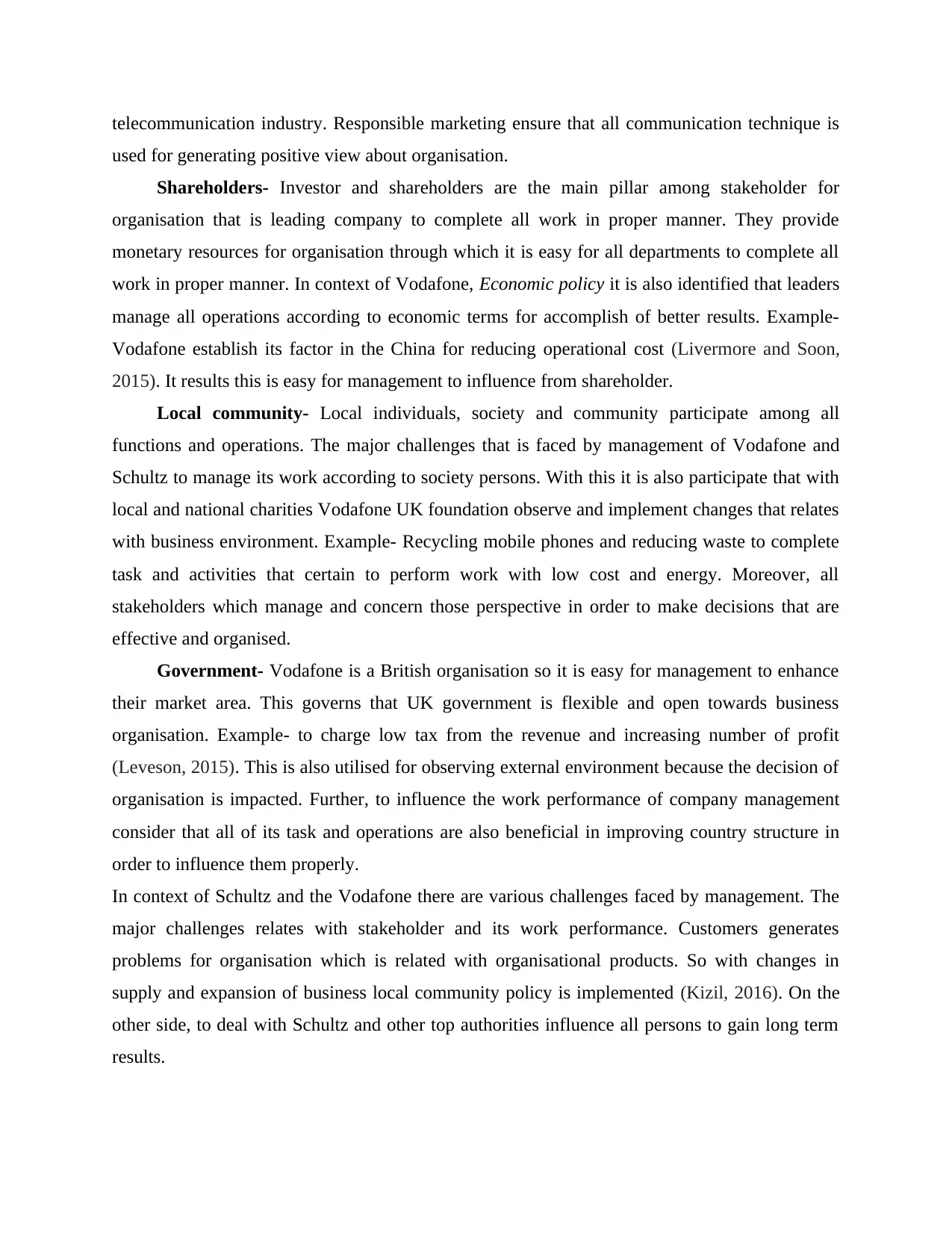
telecommunication industry. Responsible marketing ensure that all communication technique is
used for generating positive view about organisation.
Shareholders- Investor and shareholders are the main pillar among stakeholder for
organisation that is leading company to complete all work in proper manner. They provide
monetary resources for organisation through which it is easy for all departments to complete all
work in proper manner. In context of Vodafone, Economic policy it is also identified that leaders
manage all operations according to economic terms for accomplish of better results. Example-
Vodafone establish its factor in the China for reducing operational cost (Livermore and Soon,
2015). It results this is easy for management to influence from shareholder.
Local community- Local individuals, society and community participate among all
functions and operations. The major challenges that is faced by management of Vodafone and
Schultz to manage its work according to society persons. With this it is also participate that with
local and national charities Vodafone UK foundation observe and implement changes that relates
with business environment. Example- Recycling mobile phones and reducing waste to complete
task and activities that certain to perform work with low cost and energy. Moreover, all
stakeholders which manage and concern those perspective in order to make decisions that are
effective and organised.
Government- Vodafone is a British organisation so it is easy for management to enhance
their market area. This governs that UK government is flexible and open towards business
organisation. Example- to charge low tax from the revenue and increasing number of profit
(Leveson, 2015). This is also utilised for observing external environment because the decision of
organisation is impacted. Further, to influence the work performance of company management
consider that all of its task and operations are also beneficial in improving country structure in
order to influence them properly.
In context of Schultz and the Vodafone there are various challenges faced by management. The
major challenges relates with stakeholder and its work performance. Customers generates
problems for organisation which is related with organisational products. So with changes in
supply and expansion of business local community policy is implemented (Kizil, 2016). On the
other side, to deal with Schultz and other top authorities influence all persons to gain long term
results.
used for generating positive view about organisation.
Shareholders- Investor and shareholders are the main pillar among stakeholder for
organisation that is leading company to complete all work in proper manner. They provide
monetary resources for organisation through which it is easy for all departments to complete all
work in proper manner. In context of Vodafone, Economic policy it is also identified that leaders
manage all operations according to economic terms for accomplish of better results. Example-
Vodafone establish its factor in the China for reducing operational cost (Livermore and Soon,
2015). It results this is easy for management to influence from shareholder.
Local community- Local individuals, society and community participate among all
functions and operations. The major challenges that is faced by management of Vodafone and
Schultz to manage its work according to society persons. With this it is also participate that with
local and national charities Vodafone UK foundation observe and implement changes that relates
with business environment. Example- Recycling mobile phones and reducing waste to complete
task and activities that certain to perform work with low cost and energy. Moreover, all
stakeholders which manage and concern those perspective in order to make decisions that are
effective and organised.
Government- Vodafone is a British organisation so it is easy for management to enhance
their market area. This governs that UK government is flexible and open towards business
organisation. Example- to charge low tax from the revenue and increasing number of profit
(Leveson, 2015). This is also utilised for observing external environment because the decision of
organisation is impacted. Further, to influence the work performance of company management
consider that all of its task and operations are also beneficial in improving country structure in
order to influence them properly.
In context of Schultz and the Vodafone there are various challenges faced by management. The
major challenges relates with stakeholder and its work performance. Customers generates
problems for organisation which is related with organisational products. So with changes in
supply and expansion of business local community policy is implemented (Kizil, 2016). On the
other side, to deal with Schultz and other top authorities influence all persons to gain long term
results.
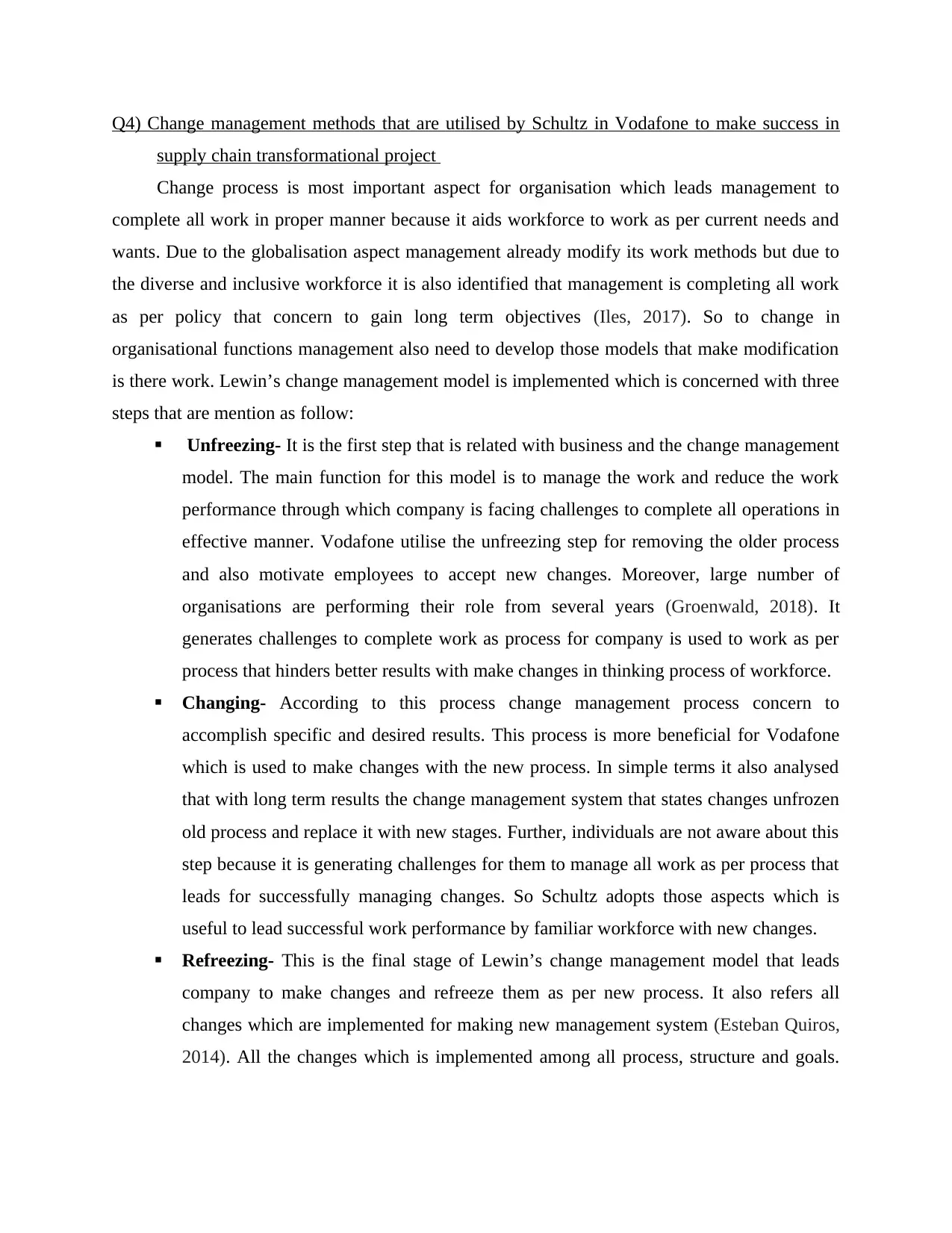
Q4) Change management methods that are utilised by Schultz in Vodafone to make success in
supply chain transformational project
Change process is most important aspect for organisation which leads management to
complete all work in proper manner because it aids workforce to work as per current needs and
wants. Due to the globalisation aspect management already modify its work methods but due to
the diverse and inclusive workforce it is also identified that management is completing all work
as per policy that concern to gain long term objectives (Iles, 2017). So to change in
organisational functions management also need to develop those models that make modification
is there work. Lewin’s change management model is implemented which is concerned with three
steps that are mention as follow:
Unfreezing- It is the first step that is related with business and the change management
model. The main function for this model is to manage the work and reduce the work
performance through which company is facing challenges to complete all operations in
effective manner. Vodafone utilise the unfreezing step for removing the older process
and also motivate employees to accept new changes. Moreover, large number of
organisations are performing their role from several years (Groenwald, 2018). It
generates challenges to complete work as process for company is used to work as per
process that hinders better results with make changes in thinking process of workforce.
Changing- According to this process change management process concern to
accomplish specific and desired results. This process is more beneficial for Vodafone
which is used to make changes with the new process. In simple terms it also analysed
that with long term results the change management system that states changes unfrozen
old process and replace it with new stages. Further, individuals are not aware about this
step because it is generating challenges for them to manage all work as per process that
leads for successfully managing changes. So Schultz adopts those aspects which is
useful to lead successful work performance by familiar workforce with new changes.
Refreezing- This is the final stage of Lewin’s change management model that leads
company to make changes and refreeze them as per new process. It also refers all
changes which are implemented for making new management system (Esteban Quiros,
2014). All the changes which is implemented among all process, structure and goals.
supply chain transformational project
Change process is most important aspect for organisation which leads management to
complete all work in proper manner because it aids workforce to work as per current needs and
wants. Due to the globalisation aspect management already modify its work methods but due to
the diverse and inclusive workforce it is also identified that management is completing all work
as per policy that concern to gain long term objectives (Iles, 2017). So to change in
organisational functions management also need to develop those models that make modification
is there work. Lewin’s change management model is implemented which is concerned with three
steps that are mention as follow:
Unfreezing- It is the first step that is related with business and the change management
model. The main function for this model is to manage the work and reduce the work
performance through which company is facing challenges to complete all operations in
effective manner. Vodafone utilise the unfreezing step for removing the older process
and also motivate employees to accept new changes. Moreover, large number of
organisations are performing their role from several years (Groenwald, 2018). It
generates challenges to complete work as process for company is used to work as per
process that hinders better results with make changes in thinking process of workforce.
Changing- According to this process change management process concern to
accomplish specific and desired results. This process is more beneficial for Vodafone
which is used to make changes with the new process. In simple terms it also analysed
that with long term results the change management system that states changes unfrozen
old process and replace it with new stages. Further, individuals are not aware about this
step because it is generating challenges for them to manage all work as per process that
leads for successfully managing changes. So Schultz adopts those aspects which is
useful to lead successful work performance by familiar workforce with new changes.
Refreezing- This is the final stage of Lewin’s change management model that leads
company to make changes and refreeze them as per new process. It also refers all
changes which are implemented for making new management system (Esteban Quiros,
2014). All the changes which is implemented among all process, structure and goals.
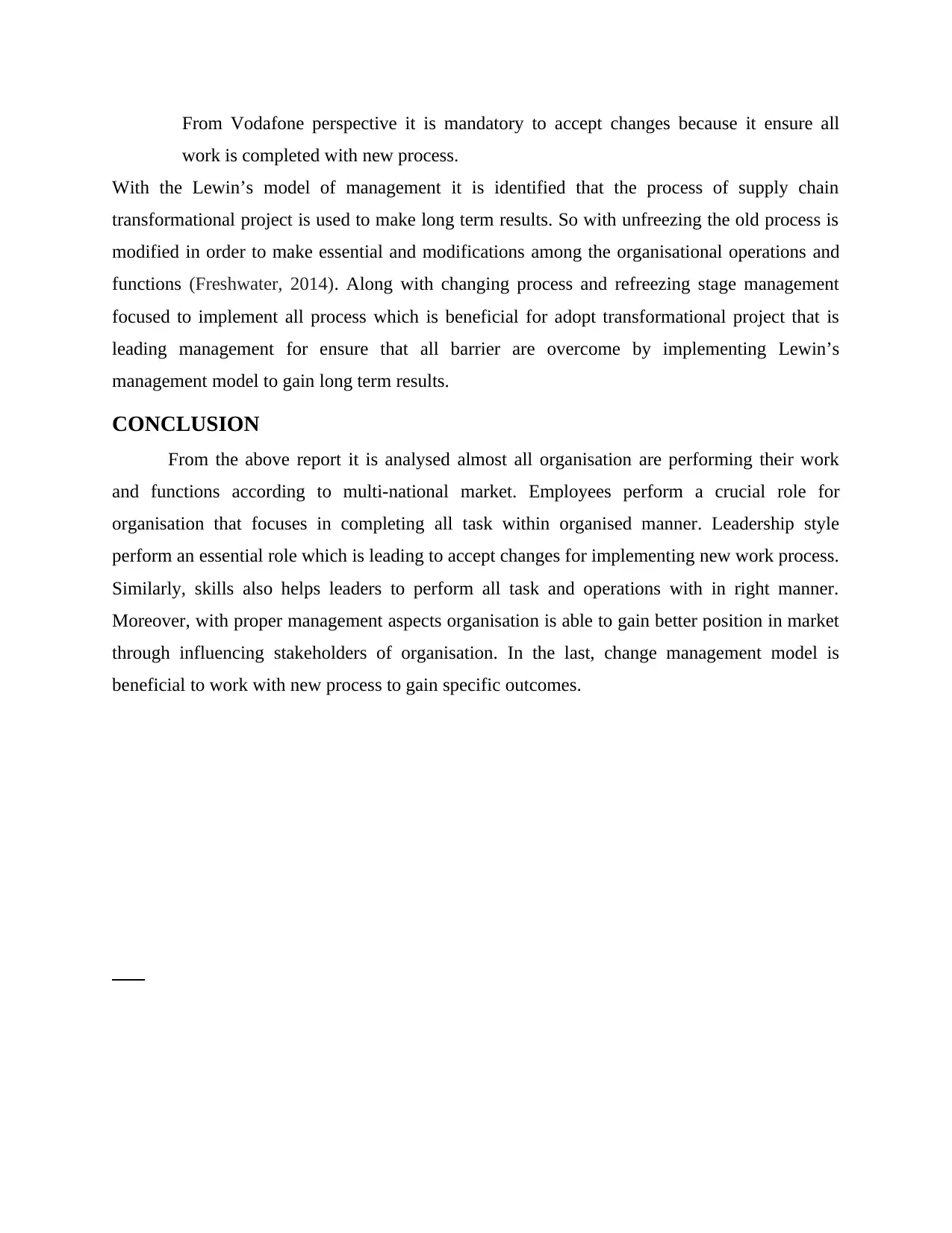
From Vodafone perspective it is mandatory to accept changes because it ensure all
work is completed with new process.
With the Lewin’s model of management it is identified that the process of supply chain
transformational project is used to make long term results. So with unfreezing the old process is
modified in order to make essential and modifications among the organisational operations and
functions (Freshwater, 2014). Along with changing process and refreezing stage management
focused to implement all process which is beneficial for adopt transformational project that is
leading management for ensure that all barrier are overcome by implementing Lewin’s
management model to gain long term results.
CONCLUSION
From the above report it is analysed almost all organisation are performing their work
and functions according to multi-national market. Employees perform a crucial role for
organisation that focuses in completing all task within organised manner. Leadership style
perform an essential role which is leading to accept changes for implementing new work process.
Similarly, skills also helps leaders to perform all task and operations with in right manner.
Moreover, with proper management aspects organisation is able to gain better position in market
through influencing stakeholders of organisation. In the last, change management model is
beneficial to work with new process to gain specific outcomes.
work is completed with new process.
With the Lewin’s model of management it is identified that the process of supply chain
transformational project is used to make long term results. So with unfreezing the old process is
modified in order to make essential and modifications among the organisational operations and
functions (Freshwater, 2014). Along with changing process and refreezing stage management
focused to implement all process which is beneficial for adopt transformational project that is
leading management for ensure that all barrier are overcome by implementing Lewin’s
management model to gain long term results.
CONCLUSION
From the above report it is analysed almost all organisation are performing their work
and functions according to multi-national market. Employees perform a crucial role for
organisation that focuses in completing all task within organised manner. Leadership style
perform an essential role which is leading to accept changes for implementing new work process.
Similarly, skills also helps leaders to perform all task and operations with in right manner.
Moreover, with proper management aspects organisation is able to gain better position in market
through influencing stakeholders of organisation. In the last, change management model is
beneficial to work with new process to gain specific outcomes.
Secure Best Marks with AI Grader
Need help grading? Try our AI Grader for instant feedback on your assignments.

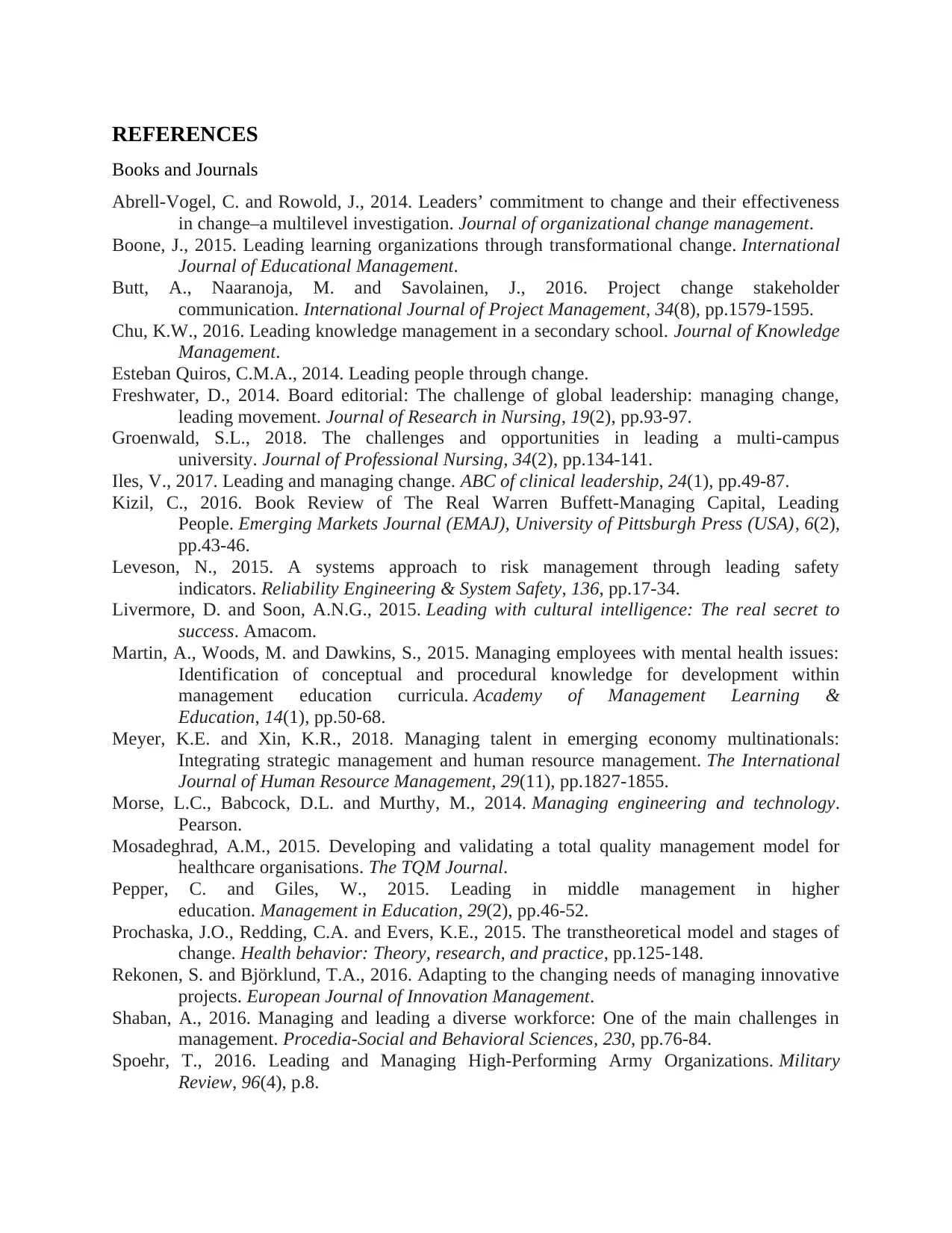
REFERENCES
Books and Journals
Abrell-Vogel, C. and Rowold, J., 2014. Leaders’ commitment to change and their effectiveness
in change–a multilevel investigation. Journal of organizational change management.
Boone, J., 2015. Leading learning organizations through transformational change. International
Journal of Educational Management.
Butt, A., Naaranoja, M. and Savolainen, J., 2016. Project change stakeholder
communication. International Journal of Project Management, 34(8), pp.1579-1595.
Chu, K.W., 2016. Leading knowledge management in a secondary school. Journal of Knowledge
Management.
Esteban Quiros, C.M.A., 2014. Leading people through change.
Freshwater, D., 2014. Board editorial: The challenge of global leadership: managing change,
leading movement. Journal of Research in Nursing, 19(2), pp.93-97.
Groenwald, S.L., 2018. The challenges and opportunities in leading a multi-campus
university. Journal of Professional Nursing, 34(2), pp.134-141.
Iles, V., 2017. Leading and managing change. ABC of clinical leadership, 24(1), pp.49-87.
Kizil, C., 2016. Book Review of The Real Warren Buffett-Managing Capital, Leading
People. Emerging Markets Journal (EMAJ), University of Pittsburgh Press (USA), 6(2),
pp.43-46.
Leveson, N., 2015. A systems approach to risk management through leading safety
indicators. Reliability Engineering & System Safety, 136, pp.17-34.
Livermore, D. and Soon, A.N.G., 2015. Leading with cultural intelligence: The real secret to
success. Amacom.
Martin, A., Woods, M. and Dawkins, S., 2015. Managing employees with mental health issues:
Identification of conceptual and procedural knowledge for development within
management education curricula. Academy of Management Learning &
Education, 14(1), pp.50-68.
Meyer, K.E. and Xin, K.R., 2018. Managing talent in emerging economy multinationals:
Integrating strategic management and human resource management. The International
Journal of Human Resource Management, 29(11), pp.1827-1855.
Morse, L.C., Babcock, D.L. and Murthy, M., 2014. Managing engineering and technology.
Pearson.
Mosadeghrad, A.M., 2015. Developing and validating a total quality management model for
healthcare organisations. The TQM Journal.
Pepper, C. and Giles, W., 2015. Leading in middle management in higher
education. Management in Education, 29(2), pp.46-52.
Prochaska, J.O., Redding, C.A. and Evers, K.E., 2015. The transtheoretical model and stages of
change. Health behavior: Theory, research, and practice, pp.125-148.
Rekonen, S. and Björklund, T.A., 2016. Adapting to the changing needs of managing innovative
projects. European Journal of Innovation Management.
Shaban, A., 2016. Managing and leading a diverse workforce: One of the main challenges in
management. Procedia-Social and Behavioral Sciences, 230, pp.76-84.
Spoehr, T., 2016. Leading and Managing High-Performing Army Organizations. Military
Review, 96(4), p.8.
Books and Journals
Abrell-Vogel, C. and Rowold, J., 2014. Leaders’ commitment to change and their effectiveness
in change–a multilevel investigation. Journal of organizational change management.
Boone, J., 2015. Leading learning organizations through transformational change. International
Journal of Educational Management.
Butt, A., Naaranoja, M. and Savolainen, J., 2016. Project change stakeholder
communication. International Journal of Project Management, 34(8), pp.1579-1595.
Chu, K.W., 2016. Leading knowledge management in a secondary school. Journal of Knowledge
Management.
Esteban Quiros, C.M.A., 2014. Leading people through change.
Freshwater, D., 2014. Board editorial: The challenge of global leadership: managing change,
leading movement. Journal of Research in Nursing, 19(2), pp.93-97.
Groenwald, S.L., 2018. The challenges and opportunities in leading a multi-campus
university. Journal of Professional Nursing, 34(2), pp.134-141.
Iles, V., 2017. Leading and managing change. ABC of clinical leadership, 24(1), pp.49-87.
Kizil, C., 2016. Book Review of The Real Warren Buffett-Managing Capital, Leading
People. Emerging Markets Journal (EMAJ), University of Pittsburgh Press (USA), 6(2),
pp.43-46.
Leveson, N., 2015. A systems approach to risk management through leading safety
indicators. Reliability Engineering & System Safety, 136, pp.17-34.
Livermore, D. and Soon, A.N.G., 2015. Leading with cultural intelligence: The real secret to
success. Amacom.
Martin, A., Woods, M. and Dawkins, S., 2015. Managing employees with mental health issues:
Identification of conceptual and procedural knowledge for development within
management education curricula. Academy of Management Learning &
Education, 14(1), pp.50-68.
Meyer, K.E. and Xin, K.R., 2018. Managing talent in emerging economy multinationals:
Integrating strategic management and human resource management. The International
Journal of Human Resource Management, 29(11), pp.1827-1855.
Morse, L.C., Babcock, D.L. and Murthy, M., 2014. Managing engineering and technology.
Pearson.
Mosadeghrad, A.M., 2015. Developing and validating a total quality management model for
healthcare organisations. The TQM Journal.
Pepper, C. and Giles, W., 2015. Leading in middle management in higher
education. Management in Education, 29(2), pp.46-52.
Prochaska, J.O., Redding, C.A. and Evers, K.E., 2015. The transtheoretical model and stages of
change. Health behavior: Theory, research, and practice, pp.125-148.
Rekonen, S. and Björklund, T.A., 2016. Adapting to the changing needs of managing innovative
projects. European Journal of Innovation Management.
Shaban, A., 2016. Managing and leading a diverse workforce: One of the main challenges in
management. Procedia-Social and Behavioral Sciences, 230, pp.76-84.
Spoehr, T., 2016. Leading and Managing High-Performing Army Organizations. Military
Review, 96(4), p.8.
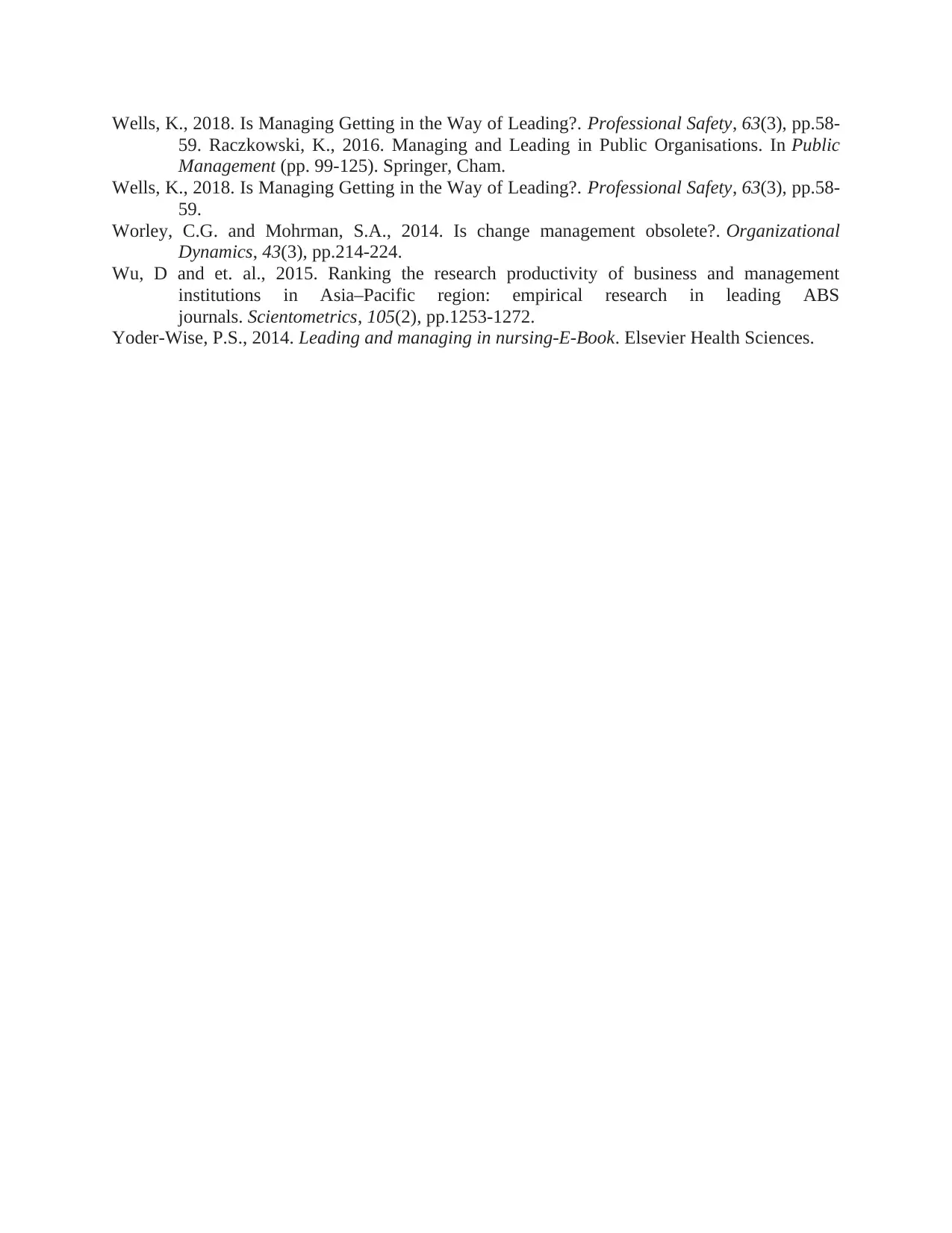
Wells, K., 2018. Is Managing Getting in the Way of Leading?. Professional Safety, 63(3), pp.58-
59. Raczkowski, K., 2016. Managing and Leading in Public Organisations. In Public
Management (pp. 99-125). Springer, Cham.
Wells, K., 2018. Is Managing Getting in the Way of Leading?. Professional Safety, 63(3), pp.58-
59.
Worley, C.G. and Mohrman, S.A., 2014. Is change management obsolete?. Organizational
Dynamics, 43(3), pp.214-224.
Wu, D and et. al., 2015. Ranking the research productivity of business and management
institutions in Asia–Pacific region: empirical research in leading ABS
journals. Scientometrics, 105(2), pp.1253-1272.
Yoder-Wise, P.S., 2014. Leading and managing in nursing-E-Book. Elsevier Health Sciences.
59. Raczkowski, K., 2016. Managing and Leading in Public Organisations. In Public
Management (pp. 99-125). Springer, Cham.
Wells, K., 2018. Is Managing Getting in the Way of Leading?. Professional Safety, 63(3), pp.58-
59.
Worley, C.G. and Mohrman, S.A., 2014. Is change management obsolete?. Organizational
Dynamics, 43(3), pp.214-224.
Wu, D and et. al., 2015. Ranking the research productivity of business and management
institutions in Asia–Pacific region: empirical research in leading ABS
journals. Scientometrics, 105(2), pp.1253-1272.
Yoder-Wise, P.S., 2014. Leading and managing in nursing-E-Book. Elsevier Health Sciences.
1 out of 13
Related Documents
Your All-in-One AI-Powered Toolkit for Academic Success.
+13062052269
info@desklib.com
Available 24*7 on WhatsApp / Email
![[object Object]](/_next/static/media/star-bottom.7253800d.svg)
Unlock your academic potential
© 2024 | Zucol Services PVT LTD | All rights reserved.





